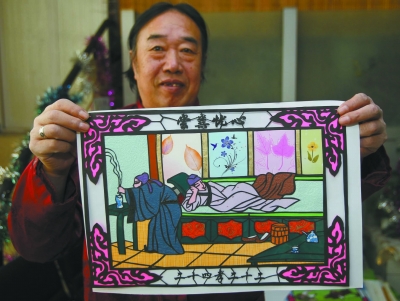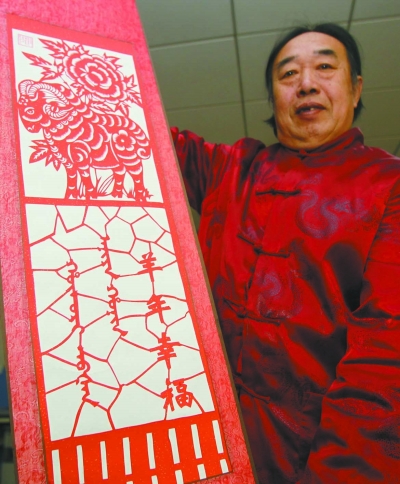The old man and Manchurian paper-cutting
By Wang Zhen
2015-02-28
When he was four years old, He Wenjiang began to study paper-cutting with his grandparents after he saw them putting paper-cut decorations on windows across the city of Jilin, Jilin province.
In recalling that excitement of almost six decades ago, he says, "At that moment I began to fall in love with this magical art", especially the first time when he saw his grandparents turn some simple red papers into beautiful decorations.
Now, He, who got a Master of Jilin Arts and Crafts award, looks back and says, "It’s definitely not an easy job".
He grew up in a family that had been doing Manchurian style of paper-cutting, a craft dating back to the Kangxi Emperor of the Qing Dynasty (1654-1722).
 |
|
He Wenjiang showing some of his paper-cut work. [Photo provided to ejilin.gov.cn] |
The traditional Chinese form of that paper art goes back as far as the Han Dynasty (206 BC-220 AD) then flourished in Tang Dynasty (AD 618–907) and Song Dynasty (960-1279).
He says that he was greatly influenced by his father, who always kept his head down and concentrated on the paper and scissors or knife, and, "My father was a graduate of Beijing’s Central Academy of Fine Arts in the late 1950s, and then got a job renovating Tian’anmen Square. But the old man left the big city and worked for the railway culture palace in remote northeastern China."
Prodded by his family, especially his father, He began to study the basic skills when he was four, then devoted himself to developing the Manchurian tradition.
But, there was a problem for him and his colleagues: the centuries-old handicraft they were working on was not a big deal in the eyes of most young people, who could easily get similar items mass-produced.
"We found ourselves in a Catch-22 situation by mid-2000," He continues, "On the one hand, we were facing a massive paper-cut market everywhere, but the old Manchurian ones had nearly been discontinued."
But, thanks to a Cultural Heritage project in 2006, He and his family decided to see if they could join the program to protect the old handicraft and began to re-do their work based on the old culture, while collecting historical materials.
And three years later, the Manchurian paper-cut craft joined the provincial cultural heritage list.
Still, He’s ambition goes beyond the government program since he hopes to promote the tradition wider and explains, "My father once offered a free paper-cut class simply to tell more people about the craft, so that’s what I’m doing," adding that he began providing free classes for thousands of primary school students in Jilin city in 2011.
 |
|
He putting a “Best wishes for the Year of the Sheep” greeting on display.[Photo provided to ejilin.gov.cn] |
"I've taught them how to cut out a Lei Feng," referring to the Maoist ideal of earnestness and service, "on a piece of paper, leaving them with a deep impression."
In his spare time, this old master has passed on the craft to his daughter in the same way the elder generation taught it to him and notes, "I passed on all the techniques, including color processing, formal cutting, and patterns to her and even to my 9-year-old grandson who has learned the basics."
Now the He family hope to promote the tradition across a wider area to get more people interested and, one of the things they’ve been doing is to make paper-cut illustrations for 70 poems from a primary school textbook as a nice way to illustrate poems and make them easier to remember.
"I hope to get it published one day and pass it on to them," He said.




